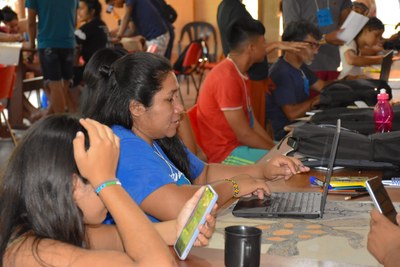New Technologies: Young People Learning to Use Communication to Fight for Indigenous Rights
August/September, 2024 (*) – It took Wirapitang Ka'apor 24 hours to cross nearly 800 km between his home at the Xiepihürenda village (in the Alto Turiaçu Indigenous Land, in northern Maranhão, near the state border with Pará) and the Timbira Pënxwyj Hëmpejxà Teaching and Research Center, in the municipality of Carolina, in the same state. Meanwhile, Phakim Krahô began a similar journey from the Recantos dos Irmãos village, in the Kraolândia Indigenous Land, in northern Tocantins.
Phakim, Wirapitang, and 39 other young Indigenous from the Apinajé, Araribóia, Bacurizinho, Cana Brava, Carú, Escalvado, Governador, Krikati, Porquinhos, Rio Pindaré, and Taquaritiua territories left their homes to participate in the in-person module of the second cycle of the Training Program for Indigenous Communicators in Maranhão and Northern Tocantins, from July 29 to August 1. The program will run until December with weekly online meetings “in the little square”—as they usually refer to the virtual meeting platforms.
The training will strengthen the communication skills of Indigenous Peoples, allowing them to tell their stories in their own voices and talk about their struggles and achievements. This USAID-supported initiative is led by the Centro de Trabalho Indigenista (CTI) and Instituto Sociedade, População e Natureza (ISPN) in partnership with Indigenous organizations under the project named Alliance of Indigenous Peoples for the Forests of Eastern Amazon: Conserve, Protect, and Restore. It is directed at young people from the Apinajé, Kanela Memõrtumré, Kanela Apanyekrá, Gamella, Gavião, Guajajara, Ka'apor, Krikati, Krahô, and Tembé peoples, all part of the Tupi and Timbira groups.
Tool for Resistance and Fight – In recent years, communication has been an important tool for advocating for and promoting Indigenous rights. It helps preserve traditional cultures, fosters social mobilization, and strengthens the Indigenous movement.
The president of the Wyty-Catë Association (one of the Indigenous organizations that are partners in the project), Oscar Apinajé, points out that, in addition to training communicators, this program prepares young leaders, who benefit from political training. “You will build our project for the future of our next generations. There is no point in acquiring knowledge if you don't put it into practice. You will play an important role in your communities, defending our rights.”
For Phakim Krahô, communication is a tool for protecting their territories. “This training is something new for the Krahô. It gives us access to better knowledge, and teaches us how to communicate in a way so that non-Indigenous people may understand our message. Good communication is a form of defense—a protection for our territory.”
According to Marciel Krikati, communication and technology tools give voice to the youth. “In the past, our elders resisted through language and singing. Today, we—young people—manifest our voice through cameras, through technology. Today we have this advocacy tool, which is communication.”
CTI executive coordinator Jaime Siqueira said that, at the end of the program, Indigenous communicators are expected to be able to act as representative and influential voices for their communities. “You will play an important political role in your communities and organizations. This is central to this program. We have a focus on communication to build the capacity of new leaders. Communication does not make sense on its own, in isolation. What we are doing here is strengthening our daily fight.”
Lessons Learned – During the training, young people are introduced to photography techniques, as well as audiovisual production, graphic design, and Indigenous leadership. There are workshops on writing techniques and storytelling, social media management, and other capacity-building activities to enable communicators to develop and manage their own communication projects.
Participants receive a smartphone and a stabilizer for cell phones and computers—basically, all equipment that is required for their online activities and multimedia content production.
“We suffer so much violence within our territory, but official narratives tend to portray us, Indigenous Peoples, as the ones causing this violence. This makes me very sad. So we decided to start rewriting this narrative, for ourselves and for others who don’t know our reality, our stories," says Cruupyhre Akroá from the Gamela People.
(*) Written by Fernando Ralfer from CTI, and edited by USAID Brazil



